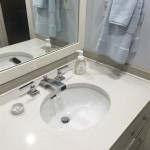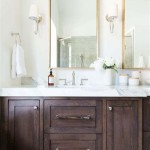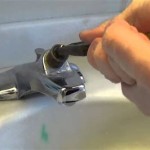```html
The Definitive Guide to Choosing the Right Paint for Bathroom Cabinets
Selecting the appropriate paint for bathroom cabinets is a critical decision that balances aesthetics with durability and longevity. The bathroom environment presents unique challenges, characterized by high humidity, temperature fluctuations, and the potential for water exposure. These factors necessitate a paint that can withstand these conditions without blistering, peeling, or developing mildew. This article provides a comprehensive overview of the various paint types suitable for bathroom cabinets, along with factors to consider when making your selection.
Understanding the Demands of the Bathroom Environment
Bathroom cabinets endure a constant barrage of moisture, steam, and temperature changes. These conditions can compromise the integrity of inferior paint finishes, leading to costly repairs or replacements. Therefore, the chosen paint must exhibit excellent moisture resistance, adhesion, and durability. Features like mold and mildew resistance are also highly desirable.
Beyond environmental factors, the paint must also withstand regular cleaning. Bathroom cabinets are prone to splashes and spills from various products, including soap, toothpaste, and cosmetics. The paint needs to be able to handle frequent cleaning without losing its color, sheen, or structural integrity.
Exploring Paint Types Suitable for Bathroom Cabinets
Several types of paint are suitable for bathroom cabinets, each offering its own set of advantages and disadvantages. A careful consideration of these properties will help in making an informed decision.
Oil-Based Paint: Oil-based paints have traditionally been a popular choice for cabinets due to their durability and resistance to moisture. They create a hard, smooth finish that is less prone to chipping and scratching compared to some other types of paint. Oil-based paints also tend to level well, minimizing brush strokes and creating a more professional-looking finish.
However, oil-based paints have several drawbacks. They have a high VOC (Volatile Organic Compound) content, which contributes to air pollution and can pose health risks. They also require a longer drying time compared to water-based paints and necessitate the use of mineral spirits or paint thinner for cleanup. Furthermore, oil-based paints tend to yellow over time, especially in areas with limited sunlight.
Latex Paint (Acrylic): Latex paints, also known as acrylic paints, are a water-based alternative to oil-based paints. They have lower VOC content, making them a more environmentally friendly option. Latex paints dry quickly and are easy to clean up with soap and water. They also offer excellent color retention and are less prone to yellowing.
Modern latex paints have significantly improved in durability and resistance to moisture, making them a viable option for bathroom cabinets. When selecting a latex paint for bathroom cabinets, it is crucial to choose a high-quality acrylic formula specifically designed for use in humid environments. Adding a mildewcide additive can further enhance its resistance to mold and mildew growth.
Acrylic Enamel Paint: Acrylic enamel paints combine the benefits of both acrylic and enamel formulations, offering enhanced durability and a hard, glossy finish. They are highly resistant to moisture, stains, and scratches, making them an excellent choice for bathroom cabinets that are subject to heavy use. Acrylic enamel paints also adhere well to a variety of surfaces, including wood, metal, and laminate.
The glossy finish of acrylic enamel paint can be both an advantage and a disadvantage. While it provides a durable and easy-to-clean surface, it can also highlight imperfections in the cabinet surface. Therefore, proper surface preparation is essential when using acrylic enamel paint.
Epoxy Paint: Epoxy paints are known for their exceptional durability and resistance to chemicals, abrasion, and moisture. They create a hard, impermeable coating that is ideal for high-traffic areas and environments with extreme conditions. Epoxy paints are often used on floors and other surfaces that require maximum protection.
While epoxy paint offers superior durability, it can be more difficult to apply than other types of paint. It typically requires multiple coats and a specific application technique to achieve a smooth, even finish. Epoxy paints also tend to have a strong odor and may require special ventilation during application. Furthermore, the glossy finish of epoxy paint may not be suitable for all bathroom styles.
Key Considerations for Paint Selection
Choosing the right paint involves more than just selecting a type; it requires careful consideration of several factors related to the cabinets themselves and the desired aesthetic outcome.
Surface Preparation: Proper surface preparation is arguably the most important step in achieving a durable and long-lasting paint finish. Regardless of the type of paint chosen, the surface must be clean, dry, and free of any loose or flaking paint. Existing paint should be sanded to create a smooth surface for the new paint to adhere to.
If the cabinets have a glossy finish, they should be thoroughly deglossed using a chemical deglosser or by sanding with fine-grit sandpaper. This will help the new paint adhere properly and prevent it from peeling or chipping. Any holes or imperfections should be filled with wood filler and sanded smooth before painting.
Priming the cabinets is also highly recommended, especially if they are made of unfinished wood or have been previously painted with a different type of paint. Primer helps to create a uniform surface for the paint to adhere to and can also improve the overall durability and longevity of the finish. A stain-blocking primer is particularly important if the cabinets have any stains or discoloration, as it will prevent these imperfections from bleeding through the new paint.
Sheen Selection: The sheen of the paint refers to its level of glossiness. Different sheens offer different levels of durability and aesthetic appeal. Common paint sheens include flat, matte, eggshell, satin, semi-gloss, and gloss.
For bathroom cabinets, semi-gloss or gloss finishes are generally recommended. These sheens are more durable and easier to clean than flatter sheens. They also offer better resistance to moisture and stains. However, higher sheens can accentuate imperfections in the cabinet surface, so proper surface preparation is essential.
Satin or eggshell finishes can also be used on bathroom cabinets, but they may require more frequent cleaning than semi-gloss or gloss finishes. These sheens offer a softer, more subtle look and can be a good choice for bathrooms with a more relaxed or rustic style. Flat or matte finishes are generally not recommended for bathroom cabinets, as they are not as durable or easy to clean as higher sheens.
Color Considerations: The color of the paint can have a significant impact on the overall look and feel of the bathroom. Lighter colors can make a small bathroom feel larger and more airy, while darker colors can create a more dramatic and sophisticated look.
When choosing a color for bathroom cabinets, it is important to consider the existing color scheme of the bathroom, including the color of the walls, flooring, and fixtures. Neutral colors, such as white, gray, and beige, are always a safe bet and can be easily coordinated with a variety of different styles. However, bolder colors can also be used to create a more unique and personalized look.
It is also important to consider the amount of natural light in the bathroom. Darker colors can make a bathroom feel smaller and more enclosed if it does not have a lot of natural light. In such cases, lighter colors may be a better choice.
Application Techniques for a Professional Finish
Even with the right paint, improper application can lead to a subpar finish. Mastering these techniques is important for an aesthetically pleasing and durable final product.
Brushing and Rolling: Both brushes and rollers can be used to apply paint to bathroom cabinets. Brushes are ideal for painting intricate details and edges, while rollers are better for covering large, flat surfaces. When using a brush, choose a high-quality brush with synthetic bristles that are designed for use with the type of paint you are using.
When using a roller, choose a roller with a nap length that is appropriate for the surface you are painting. A shorter nap length is better for smooth surfaces, while a longer nap length is better for textured surfaces. Apply the paint in thin, even coats, using smooth, overlapping strokes. Avoid applying too much paint at once, as this can lead to drips and runs.
Spraying: Spraying is another option for applying paint to bathroom cabinets. Spraying can provide a smooth, even finish, but it requires more preparation and skill than brushing or rolling. When spraying, it is important to use a high-quality spray gun and to follow the manufacturer's instructions carefully. It is also important to protect the surrounding areas from overspray by covering them with plastic sheeting or drop cloths.
Whether brushing, rolling, or spraying, multiple thin coats are always preferable to one thick coat. This allows the paint to dry properly and minimizes the risk of drips, runs, and other imperfections. Allow each coat to dry completely before applying the next coat, following the manufacturer's recommendations for drying time.
By understanding the challenges of the bathroom environment, carefully selecting the appropriate type of paint, and employing proper application techniques, achieving a durable and beautiful finish on bathroom cabinets is possible. The result will be cabinets that not only enhance the aesthetic appeal of the bathroom but also withstand the rigors of daily use for years to come.
```
How To Paint Bathroom Cabinets Without Sanding 8 Vital Steps Grace In My Space

How To Paint Bathroom Vanity Cabinets Tutorial Benjamin Moore

How To Paint Cabinets Last Painting A Bathroom Vanity Maison De Pax
.jpg?strip=all)
Painting A Bathroom Vanity Again Dream Green Diy
.jpg?strip=all)
Painting A Bathroom Vanity Again Dream Green Diy

How To Paint Bathroom Vanity Cabinets Tutorial Benjamin Moore

Diy Bathroom Vanity Makeover With Behr Grey Paint

Bathroom Refresh Update With Paint Deeply Southern Home

Painting Bathroom Cabinets Nq Property Care

How To Paint Bathroom Vanity Cabinets Sherwin Williams
Related Posts







